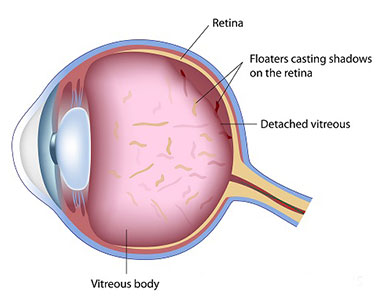Understanding Flashes and Floaters
You may sometimes see small specks or clouds moving in your field of vision. They are called floaters. You can often see them when looking at a plain background, like a blank wall or blue sky. Floaters are actually tiny clumps of gel or cells inside the vitreous, the clear jelly-like fluid that fills the inside of your eye.
Although the floaters appear to be in front of the eye, they are actually floating in the vitreous fluid inside the eye. What you see are the shadows they cast on the retina, the nerve layer at the back of the eye that senses light and allows you to see. Floaters can have different shapes: little dots, circles, lines, clouds, or cobwebs.
What Causes Floaters?
Floaters occur when the vitreous, a gel-like substance that fills about 80 percent of the eye and helps it maintain a round shape, slowly shrinks.
As the vitreous shrinks, it becomes somewhat stringy, and the strands can cast tiny shadows on the retina. These are floaters. In most cases, floaters are part of the natural aging process and simply an annoyance. They can be distracting at first, but eventually tend to “settle” at the bottom of the eye, becoming less bothersome. They usually settle below the line of sight and do not go away completely.
Other Causes of Floaters (more serious):
- infection
- inflammation (uveitis)
- hemorrhaging
- retinal tears
- injury to the eye
Symptoms of Flashes and Floaters
- Sensitivity to bright lights
- Specks floating in the central vision
In many cases, flashes and floaters are caused by age-related changes in the back of the eye. The age-related changes are specifically related to changes in the vitreous fluid (gel material). The vitreous fluid gradually becomes more viscous or watery over time. What happens after the age of 30 or so is that the vitreous might be watery enough to swallow clumps of material and is where the floaters can develop. These clumps of material floating inside the eye can cast shadows on the retina and is why people see floating spots.

Flashes and Floaters Retina Diagram

Vision with Floaters
If you live in Tennessee and are seeking treatment for flashes and floaters the eye doctors at The Regional Eye Center can help you. Patients from 4 states routinely choose our practice due to our treatment specialties and experienced ophthalmologists. We welcome you to visit our Kingsport, Tennessee eye care practice for a comprehensive eye exam to detect floaters.
Many patients often wait too long and have permanent damage. If you are serious about preventing vision loss schedule an eye exam now. It may save your vision. You will be guided by a Tennessee retina eye doctor who will examine your eyes and determine a treatment protocol.
Laser Floater Removal
Floaters and patient quality of life
While floaters can be overlooked as a common symptom of vitreous deterioration, the adverse effect that they can have on a patient’s quality of life is sometimes significant enough to warrant treatment.
Laser Floater Treatment is a minimally invasive procedure that can significantly improve a patient’s everyday visual functionality and provide them with much-needed relief from eye floaters. The doctors at The Regional Eye Center offer treatment to their symptomatic floater patients by using the Ellex laser with greater safety and better results than ever before.
ZAP Your Floaters!
Contact us today to learn more about Floater treatment options.












